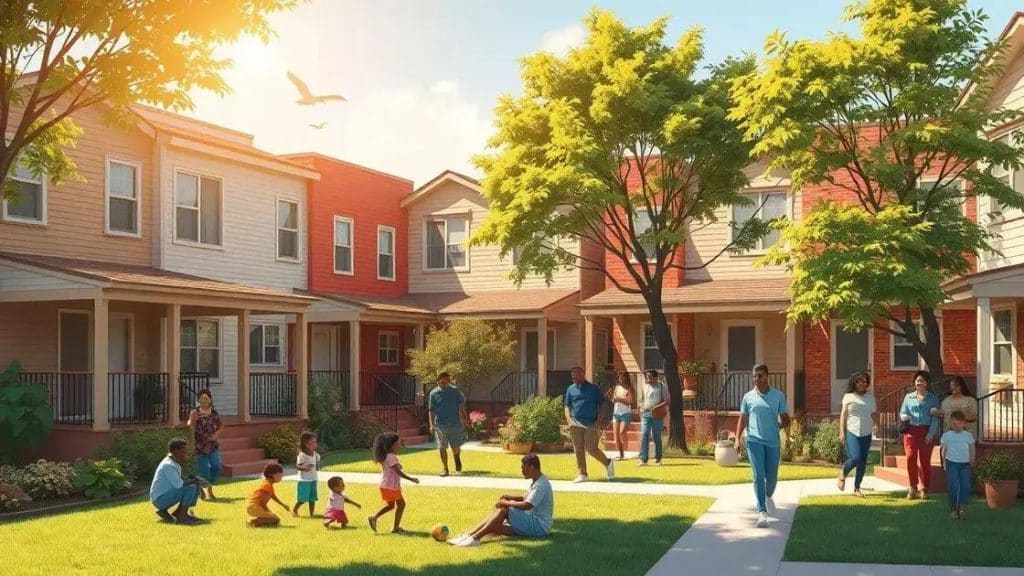Expansion of affordable housing initiatives: a new era

The expansion of affordable housing initiatives aims to provide accessible housing options, boost local economies, and foster community stability, addressing critical needs for low and moderate-income families.
The expansion of affordable housing initiatives presents a vital opportunity to enhance living conditions for many. Have you considered how these efforts can reshape communities and benefit countless families? Let’s delve into this transformative topic.
Understanding affordable housing initiatives
Understanding affordable housing initiatives is crucial for anyone interested in improving living conditions in our communities. These initiatives aim to create accessible housing options for individuals and families with low to moderate incomes. By examining various aspects of these programs, we can see their significant impact on society.
What Are Affordable Housing Initiatives?
Affordable housing initiatives are policies and programs designed to provide low-cost housing solutions. They address the growing demand for housing that is both affordable and of good quality. This is particularly important in urban areas where housing prices are rising.
Key Objectives of These Initiatives
- To reduce homelessness by providing secure housing options.
- To stimulate local economies through increased housing availability.
- To promote social equity by ensuring all community members can access stable housing.
- To enhance overall community well-being by improving living standards.
These objectives highlight how affordable housing initiatives are about more than just providing a roof over one’s head. They play a vital role in uplifting communities by fostering stability and belonging.
Furthermore, affordable housing initiatives often involve collaborations between nonprofit organizations, government entities, and private developers. These partnerships can lead to innovative solutions that maximize resources and expertise. For example, community land trusts are one approach that ensures long-term affordability by keeping housing costs manageable in the area.
It is also essential to consider the variety of funding sources that support these initiatives. Many rely on federal and state programs, along with private investments. By pooling financial resources, these programs can effectively build or rehabilitate housing that meets the needs of the community.
Benefits of expanding affordable housing
Expanding affordable housing brings numerous benefits to communities and the economy. When we consider the importance of affordable housing, we quickly realize that it is essential for stability and growth.
Economic Growth
One of the most significant advantages of expanding affordable housing is boosting local economies. When people have stable homes, they tend to spend more money in their communities. This creates jobs and improves local businesses.
Improving Community Well-Being
- Families settle down and build connections in their neighborhoods.
- Children benefit from improved educational opportunities.
- It reduces crime rates as communities become more stable.
- Health outcomes improve when people live in secure, safe environments.
These factors contribute to a vibrant community where residents support one another. Enhancing the availability of affordable housing can lead to lasting positive change.
Moreover, affordable housing fosters diversity and inclusion. By providing homes for various income levels, communities become richer and more dynamic. This mix of backgrounds promotes cultural exchange and understanding, creating a stronger social fabric.
Expansion also supports sustainability. When affordable housing is built near public transportation and job centers, it reduces travel time and transportation costs. This not only helps residents financially but also decreases the community’s carbon footprint.
Key strategies for implementation

Key strategies for the implementation of affordable housing initiatives are essential for achieving success in addressing housing needs. By focusing on effective approaches, communities can transform their housing landscapes and ensure that all residents have access to stable homes.
Collaborative Partnerships
Building strong partnerships is crucial. Local governments, nonprofit organizations, and private developers must work together. This collaboration leverages resources and expertise, ensuring a more comprehensive approach to affordable housing.
Funding and Financing Options
- Utilize federal and state grants to support housing projects.
- Explore low-income housing tax credits to attract private investment.
- Implement innovative financing methods, such as public-private partnerships.
- Encourage community investment through crowdfunding initiatives.
These funding sources play a vital role in making affordable projects financially viable. By diversifying funding strategies, communities can sustain their housing initiatives.
Additionally, it is essential to prioritize zoning reforms. Revising land use policies can streamline the development of affordable housing. Communities should consider allowing mixed-use developments, which combine residential and commercial spaces. This not only increases housing options but also enhances local economies.
Public engagement is another strategy that should not be overlooked. Involving the community in planning processes creates awareness and support for affordable housing projects. Community meetings and forums help residents voice their needs and concerns, leading to better-informed decisions.
Challenges in affordable housing expansion
Challenges in affordable housing expansion are significant barriers that many communities face. Addressing these hurdles is crucial for providing access to affordable homes for all residents. Several obstacles can hinder progress in this area.
Funding Limitations
One of the primary challenges is the lack of adequate funding. Many affordable housing projects are constrained by limited financial resources. Without sufficient funding, it becomes tough to develop new properties or maintain existing ones. This can lead to a shortage of affordable units, especially in high-demand areas.
Regulatory Hurdles
- Complex zoning laws can delay or prevent new developments.
- Permitting processes often take considerable time and resources.
- NIMBY (Not In My Backyard) attitudes can create opposition to new projects.
- Stringent building codes may make projects more expensive.
These regulatory challenges make it difficult to establish new housing that meets the growing demands of the community. Simplifying these processes can help accelerate the development of affordable housing.
In addition, there is often a lack of public awareness regarding the need for affordable housing. Many residents may not understand the implications of housing shortages. Education campaigns are necessary to inform the public about the benefits of affordable housing and counter any misconceptions.
Another obstacle is the rising costs of land and construction materials. As these prices increase, it becomes more challenging to keep housing affordable. Developers may struggle to create units that are both cost-effective and meet the needs of low-income families.
Success stories from various cities
Success stories from various cities demonstrate the effectiveness of affordable housing initiatives. By highlighting these examples, we can understand how thoughtful planning and community involvement lead to positive outcomes.
San Francisco’s Inclusionary Housing Program
In San Francisco, the Inclusionary Housing Program requires developers to include a percentage of affordable units in new housing developments. This policy has resulted in thousands of affordable homes being created, providing options for low-income families in an expensive housing market.
New York City’s Affordable Housing Lottery
- The Affordable Housing Lottery in New York City allows residents to apply for below-market rate apartments.
- Since its launch, thousands have benefited from reduced rent, enhancing community diversity.
- This system not only aids families but also revitalizes neighborhoods by incorporating various income levels.
This program showcases how structured systems can assist families in finding affordable housing options in a bustling metropolitan area.
In Houston, the city has adopted a unique approach by utilizing community land trusts. These trust organizations work to maintain long-term affordability by buying and holding land for affordable housing, ensuring that homes remain accessible for future generations. This strategy has helped prevent displacement and created stable, thriving communities.
Furthermore, in Minneapolis, the city’s decision to eliminate single-family zoning has led to an increase in affordable housing units. By allowing duplexes and triplexes, more homes can be built in neighborhoods that previously only allowed single-family homes. This change promotes diversity and increases housing availability.
FAQ – Frequently Asked Questions about Affordable Housing Initiatives
What are affordable housing initiatives?
Affordable housing initiatives are programs and policies designed to provide low-cost housing options for individuals and families, ensuring everyone has access to safe and stable homes.
How do communities benefit from expanding affordable housing?
Communities benefit from affordable housing through increased economic stability, improved social equity, and the creation of diverse neighborhoods that promote inclusivity.
What are some common challenges in implementing affordable housing?
Common challenges include funding limitations, regulatory hurdles, rising construction costs, and community opposition to new developments.
How can I get involved in supporting affordable housing initiatives?
You can get involved by attending community meetings, advocating for supportive policies, volunteering with local organizations, or educating others about the benefits of affordable housing.





